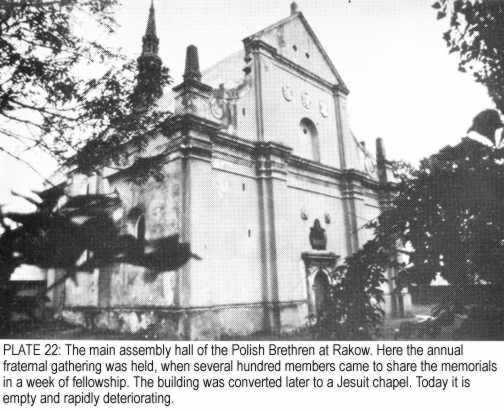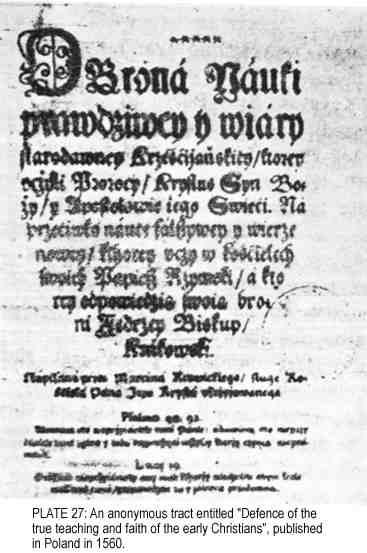
Last Updated on :
Saturday, November 22, 2014
- Information
- Articles Books Booklets
- Commentaries
- Daily Readings
- Hymns/Music
- Study Aids
- Basis of Belief
- Doctrines we reject
- Commandments of Christ
- Christadelphian Instructor
- Sisters
- Read it in a year
- Downloads PDF/Word
- Mobile Files Old Home Page
- _____
Contents|| Preface || 1 || 2 || 3 || 4 || 5 || 6 || 7 || 8 || 9 || 10 || Thanks || INDEX
Brethren In Christ
BY ALAN EYRE
All images on these pages can be viewed at a readable size by clicking on the corresponding link.
The 16th century was Poland's 'golden age'. It was then one of the largest and most powerful countries of Europe, with notable accomplishments in art, science and technology. Its universities had already become famous, and -- most unusual for its time -- it was both a parliamentary democracy and a constitutional monarchy. The Roman Catholic church, while still dominant, had its power greatly curbed by a spirit of tolerance which was as yet entirely absent in the countries of western and southern Europe. People, intelligent people, were beginning to learn to discuss and debate religious matters in a way that did not require the loser to forfeit his head or be burnt at the stake.
Some Brethren in Christ, fleeing the massacres and savage treatment meted out to them in the Germanic lands and the Italian states, arrived in Poland in the 1540's, perhaps even earlier. They found the atmosphere highly conducive to witness and ecclesial life.
Giorgio Biandrata was there in the period 1558 to 1563 and participated in an important conference at Pinczow before going on to Alba-lulia. This conference was an important step in the emergence of a well-organized, active brotherhood of believers -- the "Little Ecclesia in Poland".
Scholars in communist Poland have, during the past few years, shown a remarkable interest in the faith, ecclesial order and spiritual life of the communities of the Brethren in Christ in that country during the century of relative freedom and activity from 1546 to their expulsion and almost total suppression in 1660. A large and growing bibliography of studies, mainly of course in Polish, attests to their interest. In fact, three separate academic conferences, in 1954, 1958 and 1969 were held in Poland on the Brethren in Christ, at which many scholarly papers were presented.
It is evident that in this communist state the doctrines and practice of the Brethren in Christ are held in far higher regard than in the west, as Stanislaw Kot's appraisal testifies (see STANISLAW KOT ON THE POLISH BRETHREN). Graduate students, for example, at more than one university, have researched the life and work of many who were shepherds and teachers and writers. Many of the Polish Brethren were highly talented individuals, some of them the cream of the 16th century intelligentsia, and among them were writers, hymn composers, and poets of the highest calibre. Their best works are in fact being now taught in the state schools in Poland.
PAGE 87
These years 1546 to 1660 were thus not only the 'golden age' of Poland but of the Truth in Europe. At no time from the first century to the 20th has apostolic Christianity and a characteristic Christadelphian faith flowered so richly or had so wide an impact. A network of more than three hundred ecclesias grew throughout Poland and the Ukraine (see Map 3). Quite a number of their meeting halls can be recognized even today, after three hundred years, disguised now as farms and dwelling houses, or in some cases, empty and crumbling (see Plates 20 and 21).
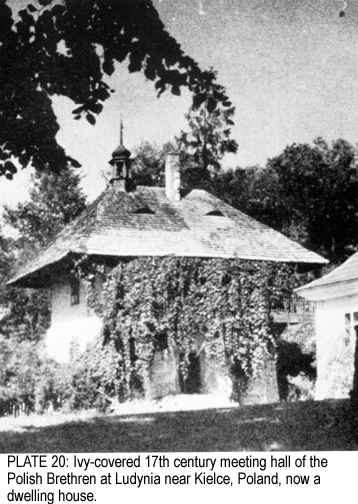
However, the most astonishing fact is this: despite the ruthlessness of their suppression in Poland and Russia, a vast amount of material has survived in archives and libraries in central and eastern Europe, of which this present volume presents only a miniscule fraction.
In Krakow, for example, is the Czartoryski Library, associated with the famous Jagellonian University where Nicholas Kupernik (Copernicus) was at one time professor. Here is unmistakable evidence of vigorous, organized ecclesias of believers in a very familiar pattern: some meeting in their own premises, others in homes; a few openly, most secretly. The Lord's Table was the very centre and core of their fellowship (see PIOTR MORZKOWSKI ON THE BREAKING OF BREAD). Their dignity, their zeal, and their courage emerge life-size from the dim past through this treasure house of material and others like it elsewhere in Poland.
It is apparent also that virtually every topic discussed in Christadelphian literature and magazines is to be found in these Polish Archives -- as the tiny selection of documents presented in this volume illustrates. It is obvious that they had to fight out every battle familiar to us, both within and without. That they had contended earnestly, yet civilly, for the Faith once for all delivered to the saints is most evident. Expositions abound on the Bible as the Word of God, inspiration, creation, the nature of the Godhead, God-manifestation, the Atonement, conversion, baptism, the kingdom of God, the true Hope of Israel, antichrist, sin, the mortality of man, resurrection, judgment, the Promises, the problem of military conscription, the Holy Spirit, the life in Christ. They evidently demanded a high level of intellectual understanding of the Word from their members, yet the word "devotion" and the need for such a spirit in all the members' lives occurs everywhere, showing that commitment was not merely of the head but truly the giving of the heart.
PAGE 88 Inset: STANISLAW KOT ON THE POLISH BRETHREN
PAGE 89 Inset: MARCIN CZECHOWIC 1532-1613
The hub of ecclesial life was the tile town of Rakow, about a hundred miles northeast of Krakow. A sympathetic nobleman, Jakob Sienienski, assigned a tract of land for a whole community of Polish Brethren and immigrants from other lands under persecution. Houses were built, farming and crafts flourished, and in 1602 a college, the Gymnasium Bonarum Artium, was established (see Map 4 and Plates 22, 23, 24, 25 and 26) 70.
It was unique for its age in that it offered a university education free from the stuffy medieval scholastic straight-jacket, and it was open to believers in any creed or none. 266
The charter of the college has been preserved, written (unusually for the period) in Polish rather than Latin, in a beautiful calligraphic hand and impressed with the seal of its patron Sienienski. The large collection of published works by members of the College faculty bear out a comment of Stanislaw Kot: "Rakow was the capital of (the Brethren's) administrative, scientific and educational work . . . under the direction of first-rate teachers native and foreign, (the college) had a long period of flourishing existence". 146
PAGE 90
MAP 3: Poland and surrounding areas of Eastern Europe about 1600. Areas where ecclesias of the Brethren were most numerous are shown stippled.
PAGE 91
PLATE 20: Ivy-covered 17th century meeting hall of the Polish Brethren at Ludynia near Kielce, Poland, now a dwelling house.
PAGE 92
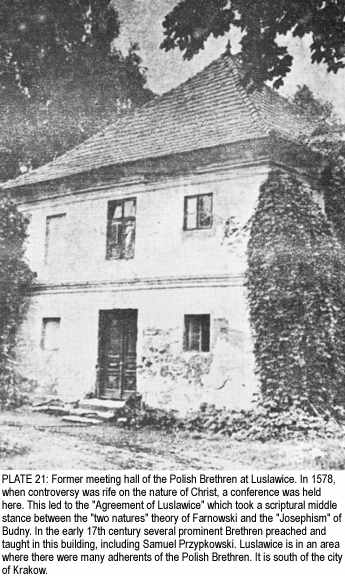 PLATE 21: Former meeting hall of the Polish Brethren at Luslawice. In 1578, when controversy was rife on the nature of Christ, a conference was held here, This led to the "Agreement of Luslawice" which took a scriptural middle stance between the "two natures" theory of Farnowski and The "Josephism" of Budny. In the early 17th century several prominent Brethren preached and taught in this building, including Samuel Przypkowski. Luslawice is in an area where there were many adherents of the Polish Brethren. It is south of the city of Krakow.
PLATE 21: Former meeting hall of the Polish Brethren at Luslawice. In 1578, when controversy was rife on the nature of Christ, a conference was held here, This led to the "Agreement of Luslawice" which took a scriptural middle stance between the "two natures" theory of Farnowski and The "Josephism" of Budny. In the early 17th century several prominent Brethren preached and taught in this building, including Samuel Przypkowski. Luslawice is in an area where there were many adherents of the Polish Brethren. It is south of the city of Krakow.
PLATE 22: The main assembly hall of the Polish Brethren at Rakow. Here the annual fraternal gathering was held, when several hundred members came to share the memorials in a week of fellowship. The building was converted later to a Jesuit chapel. Today it is empty and rapidly deteriorating.
PLATE 23: Commemorative medallion minted by the Polish Brethren, late 16th century. The Hebrew inscription at left: The man Jesus, at right; The Messiah of the Kingdom of Peace came in true human nature.
PAGE 94

MAP 4: The village of Rakow, Poland today, indicating evidence of the time when it was the centre of the Polish Brethren. The buildings which date from the 17th century are indicated. Many of the homes are still used as dwellings today.
PAGE 95
PLATE 24: This note mentions Andrzej Lubieniecki (1550-1623) who, according to a 16th century document, "o f his own accord left the court of the king, whose favour he enjoyed, and scorning both his present fortune and his expectation, he joined the hated sect of the Brethren. He ministered to ecclesias of this religion at his own expense and became a fervent champion and defender of these ecclesias". The note is signed by Samuel Przypkowski, principal of Rakow college. At the top are Jesus' words "Seek ye first the Kingdom of God and all these things shall be added unto you".
f his own accord left the court of the king, whose favour he enjoyed, and scorning both his present fortune and his expectation, he joined the hated sect of the Brethren. He ministered to ecclesias of this religion at his own expense and became a fervent champion and defender of these ecclesias". The note is signed by Samuel Przypkowski, principal of Rakow college. At the top are Jesus' words "Seek ye first the Kingdom of God and all these things shall be added unto you".
 PLATE 25: Jakob Sienienski, owner of the town of Rakow. Right: Samuel Przypkowski, principal of the Gymnasium Bonarum Artium, the Brethren's college in Rakow. Centre: One of the students charged with having thrown stones at a crucifix.
PLATE 25: Jakob Sienienski, owner of the town of Rakow. Right: Samuel Przypkowski, principal of the Gymnasium Bonarum Artium, the Brethren's college in Rakow. Centre: One of the students charged with having thrown stones at a crucifix.
The trial in 1638 of Sienienski, the College and several students, instigated by the Jesuits, resulted in the closure of the college and ultimately the exile of the Brethren from Poland.
PAGE 96
PLATE 26: King Ladislas IV of Poland giving sentence in the trial of the Brethren shown in Plate 25. Jakob Zadzik, the Chancellor of Poland is at the king's left as prosecutor, and the primate of Poland, Archbishop Jan Wezyk, is at his right. The painting was commissioned by Zadzik himself and still hangs in the episcopal palace in Kielce, central 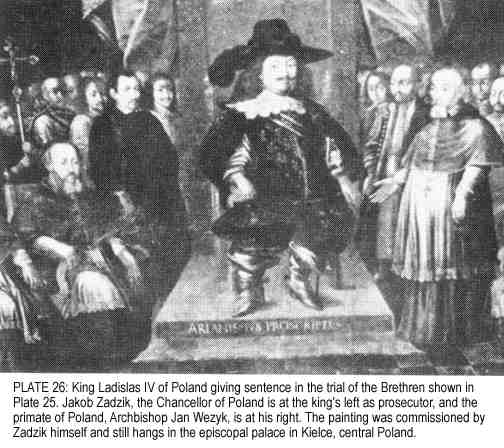 Poland.
Poland.
Most of the college buildings were destroyed in the 17th century. The publishing house and printery actually survived until just a few years ago -- the buildings, that is. The main assembly hall, dirty and unused, remains to evoke poignant memories of the fellowship in Christ which was once shared here at the annual Bible School and fraternal gathering.
"Several hundreds sat down to the Lord's Table (in 1611, 400; in 1618, 459). This communion became a symbolic bond uniting the members of the church in one body. . . those who took communion at Rakow felt the unity of the Polish Brethren ....147
The plates and selections in this volume indicate a little of the enormous output of material which came from the presses of the Brethren: Bibles (the first Bibles ever to be translated into and printed in Czech,
PAGE 97
Lithuanian, Byelorussian and Ukrainian were made by them), hymn books, instructors, polemical writings, commentaries on almost all the New Testament and parts of the Old, expositions of doctrine and prophecy, debates and various helps for the Christian warfare.
The roster of those who are known to have contributed to this virtual torrent of sound, scriptural literary output is amazingly large, considering the passage of time and the "oblivion" into which they were assigned by their contemporaries and subsequent generations. An American scholar, George H. Williams of Harvard University, has compiled a list of over two hundred names, which he still recognizes as incomplete.287 He has met living Poles who are descended from some active in the Brotherhood in the 16th and 17th centuries and who retain possession of interesting material on their forebears. Some of the biographies in this volume reflect Dr. Williams' careful and erudite research, as well as that of the modern Polish scholars whose names appear in the Bibliography to the present volume.
The freedom enjoyed by the Brethren, it should be understood was strictly relative to its age. It bore no similarity to that enjoyed in countries like Australia, Britain and Canada today. Publishing for the Brethren was an especially risky business. They would always have to prepare at a moment's notice to put everything moveable into a box or bag and make a run for it.
One determined gentleman was Alexius Radecki. His first print shop in Krakow was suppressed, so he packed his bags and moved to Rakow. He was twice imprisoned, but his son-in-law Sebastian Sternacki, receiving his father-in- law's type founts and machinery as a wedding present, became the most famed (or notorious, according to one's viewpoint!) of all their printers.112 One splendid product of his press, printed in 1613 at Rakow, is a two-volume work by Adam Goslawski, an "exceedingly rare" collector's item now in the library of Manchester College, Oxford.109
There was always a nagging problem for civil servants, as they were normally expected to swear allegiance by holding a crucifix and adjuring the Trinity. Both were abhorrent to the Brethren. Although some superiors turned a blind eye, the test case of Jan Tyshkovych which ultimately reached the Supreme Court in Warsaw starkly reveals the peril. His appeal was dismissed and the sentence of the royal magistrates of Queen Constantia has been preserved in a brief biographical note by one of the Brethren:
PAGE 98
PLATE 27: An anonymous tract entitled "Defence of the true teaching and faith of the early Christians", published in Poland in 1560.
PAGE 99
PLATE 28: "Instructor" printed for Marcin Czechowic. The title reads "Thirteenth lesson on Baptism and the Breaking of Bread". It is in [he form of a discussion between candidate or instructee (Vczen) and instructing brother (Navczyciel).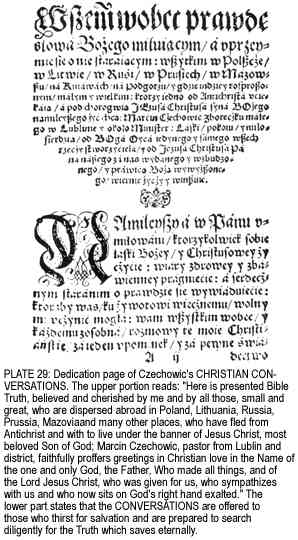
PAGE 100
PLATE 29: Dedication page of Czechowic's CHRISTIAN CONVERSATIONS. The upper portion reads: "Here is presented Bible Truth, believed and cherished by me and by all those, small and great, who are dispersed abroad in Poland, Lithuania, Russia, Prussia, Mazovia and many other places, who have fled from Antichrist and wish to live under the banner of Jesus Christ, most beloved Son of God; Marcin Czechowic, pastor from Lublin and district, faithfully proffers greetings in Christian love in the Name of the one and only God, the Father, Who made all things, and of the Lord Jesus Christ, who was given for us, who sympathizes with us and who now sits on God's right hand exalted." The lower part states that the CONVERSATIONS are offered to those who thirst for  salvation and are prepared to search diligently for the Truth which saves eternally.
salvation and are prepared to search diligently for the Truth which saves eternally.
PAGE 101
PLATE 30: Title page of a catechism of the Polish Brethren. It reads: "Catechism of the assemblies of those persons who, in the kingdom of Poland, the Grand Duchy of Lithuania and in other of the king's domains, do affirm and confess that the Father of our Lord Jesus Christ is the one and only God of Israel, and that the man Jesus of Nazareth, who was born of a virgin, and no other besides him, is the only begotten Son of God". The quotation from Hosea 14: 10 (v. 9 in the English Bible) reads: "The ways of the Lord are right; and the just shall walk in them, but the perverse shall fall therein".
PAGE 102
"Seeing that he has blasphemed, his tongue will be cut out. Since he has thrown down the image of the crucifix and trampled on it, his hands and feet will be cut off. Since he has held the magistrates in contempt and because he has been stubborn, he is to be beheaded as a rebel. Finally, he is to be burned as a
heretic."268
The growth of membership and the development of ecclesial life, as today, required a supply of sound material both to convert the alien and build up the believer. There were fortunately many capable writers among the Polish Brethren, and the Bible Class was a vital institution among them. Many notes and addresses for these classes have been preserved, indicating a serious attention, albeit a balanced one, to both sound doctrine and its practical application in daily life. After the expulsion of 1660, when activity in Poland had largely ceased, Benedykt Wiszowaty reminisced about the classes that had been held in Krakow:
"Several men experienced in divine matters shared the work with one another, each one conducting classes twice daily in his own quarter. They (groups of Brethren) gathered at stated times to inquire into the meaning of the holy writings and to draw it out. Jonasz Szlichtyng was in charge of these meetings and explained here a great part of the New Testament with his commentaries. While often pressed by hunger and cold, yet by the goodness of God they were never reduced to extremities." 293
It would be misleading to imply that any particular aspect of the Truth was overly emphasized, for this was not so, but there is no doubt that the Brethren viewed the doctrine of the Atonement as absolutely fundamental to a sound understanding of the way of salvation, as several selections in the present volume demonstrate.
It is important to understand something of the theological background which made the question of the Atonement so controversial an issue. One religious historian, discussing the church squabbles over this question in the 16th century, succinctly lays out the orthodox Roman Catholic doctrine which, he asserts, the major reformers took over "without question":
"This doctrine, based on the principle of Divine Justice, was that the infinite guilt of human transgression required an infinite penance, and hence the death of an infinite Being, the
PAGE 103 Inset: JONASZ SZLICHTYNG 1592-1661
PAGE 104
PLATE 31: Manuscript on "The Ways of Providence" by Jonasz Sziichtyng, Jnr., son of the more famous Jonasz, Snr. This was written about four years after his father's death.

PAGE 105 Inset: JONASZ SZLICHTYING ON THE SON OF GOD
Inset: JONASZ SZLICHTYING ON GOD'S FOREKNOWLDGE OF CHRIST
PAGE 106 Inset: JOHANN KRELL ON THE SOUL
PAGE 107 Inset: JOHANN KRELL 1590-1633
PAGE 108
God-man, Jesus Christ. God, through His Son, Himself secured the forgiveness or salvation of believing humanity. His justice was satisfied by a representative or substitutionary satisfaction, for between the claim and the satisfaction there was, under these circumstances, an equivalence. What the Reformation did in this connection was merely to insist that through the Atonement mankind had been redeemed once for all, so that thenceforth there was no need for the elaborate sacerdotal machinery which had been developed in Roman Catholicism as an indispensable basis, or instrument, of man's salvation."141
An even cruder version portrayed Jesus' blood as the price God paid to the Devil for the release of the human race. Both Calvinism and Arminianism (a Dutch version of Protestantism), while -- like the Jewish Pharisees -- restricting the effects of the Atonement to a predestined group of special "elect", nevertheless retained the theory of substitution. Alone among the churches of that age, the Brethren in Christ demolished and discarded the whole edifice and apparatus of substitutionary theology. They presented the work of Christ as "the reconciliation of men to God rather than of God to men. The Passion
PAGE 109
PLATE 32: An anonymous 17th century attempt to translate one of Johann Krell's doctrinal works into English, printed secretly, probably in London.

PAGE 110 Inset: ON THE HOLY SPIRIT From A Catechism of the Polish Brethren
PAGE 111 Inset: QUESTIONS AND ANSWERS ON THE NATURE OF MAN
PAGE 112-113 Inset: FLORIAN KRAUS ON ECCLESIAL DISCIPLINE
PAGE 113-114 Inset: BIBLE CLASS NOTES ON JOHN 3:16
PAGE 115 Inset: HIERONIM MOSKORZOWSKI ON SATISFACTION AND REDEMPTION
PAGE 116 Inset: HIERONIM MOSKORZOWSKI 1560-1629
was a declaration of God's love and an incentive to lead men to seek salvation". They showed that once the redeeming work of Christ is put in proper perspective in God's plan for man's salvation, "the most telling argument for the traditional substitutionary theory falls to the ground".141
Understanding the sacrificial work of Christ depends upon rightly appreciating his nature and origin, recognizing in Jesus Christ not the second person of an unscriptural Trinity but as Deity manifested in human flesh, the Father revealed to men. It was this uncompromising belief in the Jesus of the Bible and not of the Romanist creeds that led
PAGE 117
ultimately to the ruthless suppression of the Brethren by the Catholic dominated Polish Parliament.
The Dutch historian N. van der Zijpp draws the dark cloud over the final days of freedom:
"There were about three hundred Polish Brethren congregations. Until 1638 The Brethren church could meet undisturbed protected by independent and liberal noblemen. In this year, however, through the machinations of the Jesuits, the Parliament of Poland resolved to close the Rakow University. Also their printing shop was closed. From then the suppression of the Brethren church began. A number of its preachers were banished from the country; others voluntarily went into exile. The congregations only secretly and with great danger could meet for worship. This too came to an end in 1658. Then the Parliament forbade their confession on pain of death. Only those who were willing to embrace the Roman Catholic creed were allowed to remain in the country. Thereupon most of them left Poland."305
Inset: THE PRZYPKOWSKI FAMILY
PAGE 118 Inset: SAMUEL PRZYPKOWSKI ON RESPONSIBILITY TO JUDGEMENT
PAGE 119 Inset: JOHANN LUDWIG WOLZOGEN 1599-1648
PAGE 120-121 Inset: JOHANN WOLZOGEN ON WAR
PAGE 122
PLATE 33: Title Page of a Latin edition of Johann Ludwig Wolzogen's works, published secretly in Amsterdam (Irenopolis = City of Peace in Greek).
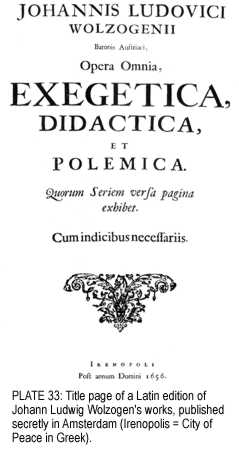
PAGE 123 Inset: TROUBLES DURING THE THIRTY YEARS' WAR
PAGE 124 Inset: STANISLAS LUBIENIECKI 1623-1675
PAGE 125 Insert: "ALMOST PERSUADED" (Acts 26:28)
PAGE 126 Inset: WACLAW POTOCKI ON JAMES 5
Inset: ANDRZEJ WISZOWATY ON UNDERSTANDING THE BIBLE
PAGE 127 Inset: ANDRZEJ WISZOWATY 1608-1678
PAGES 128-129 Inset: THE GREAT DEBATE AT ROZNOW 1660
PAGE 130
PLATE 34: First page of Andrzej Wiszowaty's Narratio Compendiosa, which asserts that the Polish Brethren's beliefs on the nature of the Godhead are apostolically based, and explains how these came to be part of their faith.
PAGE 131 Inset: MARCIN RUAR 1588-1657 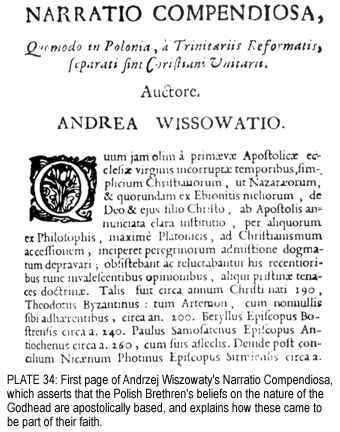
All Books/Booklets, Editorials, and Articles are FREE and can be downloaded without permission.
